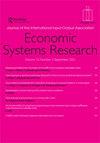零售贸易利润分配在家庭部门碳足迹计算中的作用
IF 1.8
4区 经济学
Q2 ECONOMICS
引用次数: 1
摘要
投入产出(IO)分析固有的同质性假设意味着,在一个产品组内花费的每一欧元都被分配了相同的环境负担。我们通过将IO表与微观层面的家庭消费数据联系起来,将这一假设应用于家庭支出从购买者价格到基本价格的价格转换。我们对两个消费群体(食品和商品)在家庭支出十分位数中的零售贸易利润率的不同分配进行了敏感性分析。虽然不同分配的零售贸易利润会影响家庭部门的碳足迹,但它并不挑战支出较高的家庭负责较高足迹的一般发现。这一发现也适用于不同排放强度的零售贸易利润率。本文章由计算机程序翻译,如有差异,请以英文原文为准。
The role of allocation of retail trade margins across household segments on their carbon footprint calculation
The homogeneity assumption, inherent to input–output (IO) analysis, implies that every euro spent within one product group is assigned the same environmental burden. We address this assumption applied to price conversion of household expenditures from purchasers’ to basic prices when the carbon footprint of consumption is calculated for specific household segments by linking the IO table and micro-level household consumption data. We perform a sensitivity analysis of the different allocations of the retail trade margin of two consumption groups (Food and Goods) across household expenditure deciles. While a differently allocated retail trade margin influences the carbon footprint of household segments, it does not challenge the general finding that households with higher expenditures are responsible for higher footprints. This finding holds also for different emission intensities of retail trade margins.
求助全文
通过发布文献求助,成功后即可免费获取论文全文。
去求助
来源期刊

Economic Systems Research
ECONOMICS-
CiteScore
5.60
自引率
4.00%
发文量
17
期刊介绍:
Economic Systems Research is a double blind peer-reviewed scientific journal dedicated to the furtherance of theoretical and factual knowledge about economic systems, structures and processes, and their change through time and space, at the subnational, national and international level. The journal contains sensible, matter-of-fact tools and data for modelling, policy analysis, planning and decision making in large economic environments. It promotes understanding in economic thinking and between theoretical schools of East and West, North and South.
 求助内容:
求助内容: 应助结果提醒方式:
应助结果提醒方式:


